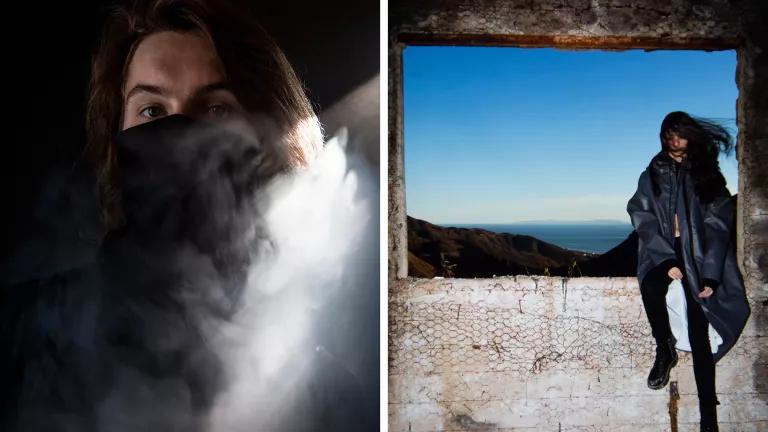Climate Change Takes Fashion Week by Storm (and by Drought and by Fire . . .)
Model, actor, and designer Luka Sabbat can make just about anything look good—even an air mask. Behold the future of fashion.

An air-filtering bandana (left); and a fireproof, water-resistant jacket (right).
All eyes are on Luka Sabbat.
By the time he arrives (late to his own show, due to walking the runway for New York’s Fashion Week just hours before), the line to get into the launch party for his exhibition, “Unfortunately, Ready to Wear,” runs down the block. The crowd—stacked with Instagram celebrities, young models and designers, and even a Hilton brother—runs decidedly more NYC cool kid than stereotypical environmental activist, but the exhibit’s goal is that by the time they leave, they’ll be both.
Already a star of social media and television screens, the 21-year-old designer has a huge sphere of influence, and Sabbat hopes his new conceptual fashion line will get people talking . . . about climate change. The exhibit, resulting from a partnership between Sabbat, the design studio Milk, and NRDC, is on display in New York City’s Meatpacking District and features some low-key but stylish gear for a carbon-fueled future.
The hypothetical wardrobe prepares would-be wearers for five daunting climate change scenarios: extreme storms, prolonged heat waves, choking air pollution, outbreaks of infectious disease, and life as an environmental refugee.
A coal-black bandana, made from a soft yet air-filtering fabric, allows you to breathe easy when air quality is plummeting from wildfire smoke, industrial emissions, rising temperatures, or all three. And a jacket keeps out the elements with magnetic closures—because who has time to zip up when you’re running from a wildfire, or to unzip as you’re swept away in a flash flood?
A good go-bag would give climate refugees a leg up when living off the land. Inside Sabbat’s waterproof nylon backpack, which doubles as a sleeping bag, are tools to help filter contaminated water and find suitable soil for growing food.
And as states of emergency become part of your daily routine, solar-powered headphones would be a necessary accessory to live-stream news updates on anything from hurricanes to heat waves.
Sabbat describes his collection as “future-forward,” but the exhibit also nods to present climate-related disasters through its photographs, the work of frequent Sabbat collaborator Noah Dillon. In Dillon’s photo shoot of the “Unfortunately, Ready to Wear” collection, what appears to be an apocalyptic futurescape is actually the hills of Malibu, California. Near Sabbat’s current home base, Malibu was the site of the devastating Woolsey Fire last fall, part of the state’s deadliest wildfire season on record.
The photo shoot was initially going to take place in Milk’s Los Angeles studio, says Emma Banks, Milk’s editorial director, but Sabbat and Dillon pushed to move it outdoors, to be within the environment that’s already feeling climate change firsthand. “That was important to them,” she says, “to make sure they didn’t feel out of touch, inside a shiny white studio, when these disasters are already so real to so many people.”
“If it comes down to the world burning down, who gives a shit about a pair of jeans that looks cool,” Sabbat says in a Youtube video that premiered at the launch. “It’s about functionality, like making a fireproof jacket.”


Putting functionality first is new territory for Sabbat, whose meteoric success is the result of curating cool online. As one of the self-proclaimed “first Internet fashion kids of New York,” he has a personal Instagram following of some 1.7 million people. His spinoff creative brand, Hot Mess, has another 36,000.
But Sabbat acknowledges that tweeting and hashtagging about climate change aren’t enough. “It’s so easy to be a pretend activist,” he notes. His hope is that his followers and others will visit the exhibition’s website, where they can pledge to tailor their own climate-friendly lifestyles—by riding public transit, preventing food waste, and cutting down on plastic consumption.
Jordan Ritz – MILK DGTL
In addition to taking such small but meaningful steps, visitors can raise their voices in demanding climate action from industries, corporations, and politicians. The International Panel on Climate Change says we need to get a handle on carbon emissions within 20 years to fend off the worst of their effects—and, one hopes, render Sabbat’s clothing line useless. His generation could be among the first to see the consequences of surpassing the atmosphere’s carbon tipping point. It may also be the last with a chance to do something to fend that off.
If anyone can make climate activism go viral, I’d bet on Sabbat.
This article was originally published on onEarth, which is no longer in publication. onEarth was founded in 1979 as the Amicus Journal, an independent magazine of thought and opinion on the environment. All opinions expressed are those of the authors and do not necessarily reflect the policies or positions of NRDC. This article is available for online republication by news media outlets or nonprofits under these conditions: The writer(s) must be credited with a byline; you must note prominently that the article was originally published by NRDC.org and link to the original; the article cannot be edited (beyond simple things such grammar); you can’t resell the article in any form or grant republishing rights to other outlets; you can’t republish our material wholesale or automatically—you need to select articles individually; you can’t republish the photos or graphics on our site without specific permission; you should drop us a note to let us know when you’ve used one of our articles.

When Art Mimics Highway Signage
What Is the Air Quality Index?
How to Make an Effective Public Comment